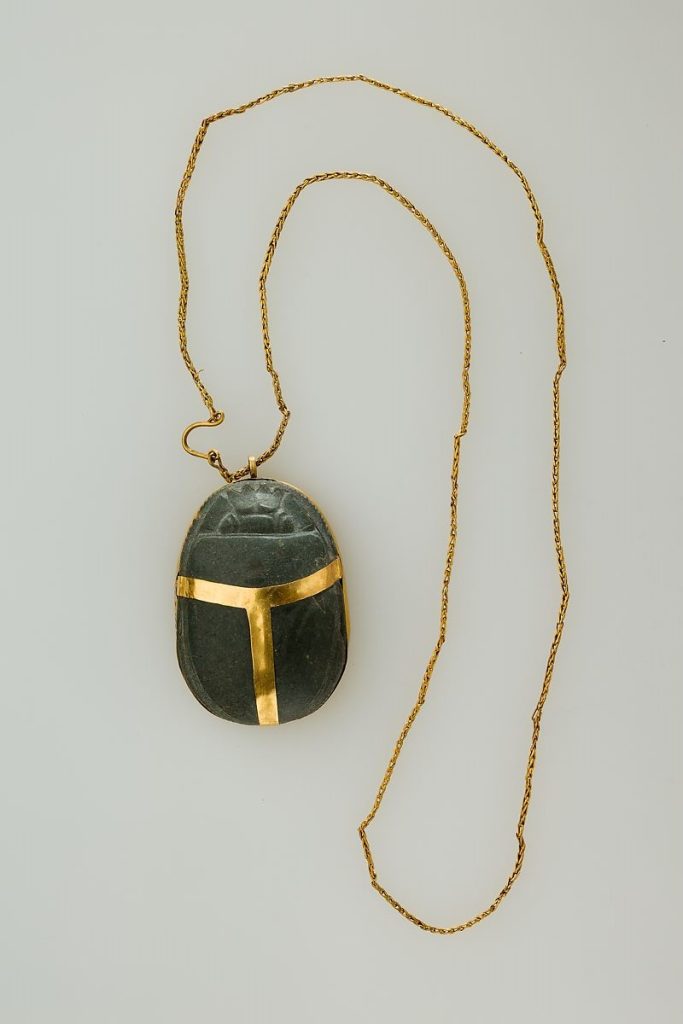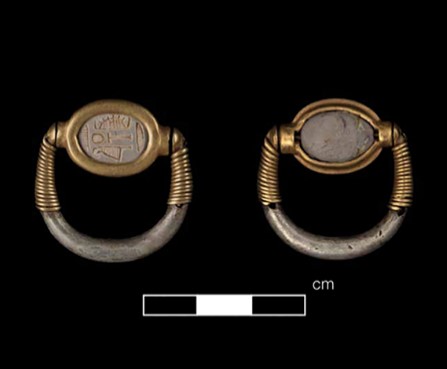As announced last week, the first preliminary report about Kerma cemetery GiE 003 in Attab/Ginis East has just been published (Budka 2022).
Today, I would like to discuss one of the highlights from this cemetery which was published in the EVO paper: a glazed steatite royal scarab with the name of a Hyksos king.

Found in Feature 4, the name of Pharaoh Y’amu is given on the bottom of this piece, MUAFS 005. Already on the day of its discovery, Manfred Bietak kindly helped remotely with the initial reading of the royal name of this scarab – many thanks for this! I am also particularly grateful to Karin Kopetzky, who provided detailed information about the dating criteria of this piece. The design of its back, head, legs, and sides all directly correspond to other known attestations of Y’amu (Tufnell 1984, 32, 35, 37, pl. 61: 3416, 3417, 3418, 3419; Ward 1984, 164) whose exact position within the sequence of 15th Dynasty rulers is unfortunately not clear (see Ben-Tor 2007, 107-108).
Scarabs are in general rare in cemetery GiE 003 and only two pieces have been found in our excavations. The context of scarab MUAFS 005, Feature 4, appears to belong to the later part of the Classic Kerma period, possibly contemporaneous with the Theban 17th Dynasty. As is known from other marginal regions of the Kerma empire like the Fourth Cataract area, our Hyksos scarab might have been circulating in Nubia for some time before ending up in GiE 003’s Feature 4.
The Hyksos king Y’amu has not been attested to in Nubia before the discovery of his scarab MUAFS 005 in GiE 003. Interestingly, in Ward’s sequence he would postdate the other Hyksos rulers attested to at Sai and Kerma as well as at the northern sites. Ward (1984, 164) placed Y’amu in the second half of the 15th Dynasty, but this sequence has been discussed and is not archaeologically confirmed (Ben-Tor 2007, 108 with references).
The textual evidence for contact between Kerma rulers and Hyksos kings has already been addressed from a variety of perspectives. In this context, the appearance of Tell el-Yahudiyeh ware in Nubia and of Kerma wares in Egypt, especially at the Hyksos capital Avaris, were also noted as possible indicators of exchange. Alexander Ahrens and Karin Kopetzky recently examined the appearance of Hyksos scarabs in the context of Kerma burials (Ahrens, Kopetzky 2021). Royal Hyksos scarabs are known from Ukma, Akasha, Sai, and Kerma, as well as several Lower Nubian sites (Aniba, Dakka, Sayala, Masmas, Faras, Mirgissa, Uronarti and Debeira). All of the kings mentioned on these sealings ruled during the early Hyksos period, and it is logical to assume that this was when the Hyksos engaged in direct trade with the Kerma kingdom (Ahrens, Kopetzky 2021, 295 with references and discussion). During the early Second Intermediate Period, the fortresses in Lower Nubia were under Kerma control, and the Hyksos were probably keen to establish trade and direct contact to achieve “continued access to resources and particularly to the Nubian gold essential for trade in the Eastern Mediterranean” (Ahrens, Kopetzky 2021, 295). The Lower Nubian fortresses have always been linked to gold mines and access to gold – recent work has stressed also the importance of Kerma gold working sites in Batn el-Haggar (Edwards 2020, 406-407; 415), and the same is likely for the Attab to Ferka region, especially for Ginis and Kosha. Could the Hyksos scarabs found at Ukma, Akasha, and Sai reflect not only international trade but also, indirectly, gold exploitation between the Second and Third Cataracts during Kerman rule? And could the same apply for the newly found scarab in Ginis?
It is tempting to assume that this new Hyksos scarab can be seen in connection to an intense period of Kerman exchange with the Hyksos kingdom, which sought gold from not only former Egyptian fortresses in Lower Nubia but also sites further south under Kerma rule. Sai’s importance during the Kerma Period might be linked to both the island’s strategic position and its location in a gold-rich region, making it ideal for supervising gold exploitation as we know it from the New Kingdom. Maybe the halting of trade with the Hyksos in the second part of the 15th Dynasty was one of the reasons why the character of Sai as a Kerman stronghold changed during Classic Kerma times (for this change see Gratien 2014; Manzo 2016). It remains to establish possible changes towards the end of the Classic Kerma period in marginal regions like Ginis – and cemetery GiE 003 with its use from Middle Kerma to Classic Kerma times and its close proximity to gold exploitation sites (as well as its connection to desert nomads presumably involved in the gold trade) has here lots of potential for future analysis.
References:
Ahrens, Kopetzky 2021 = A. Ahrens, K. Kopetzky, “Difficult times and drastic solutions: the diffusion of looted Middle Kingdom objects found in the northern Levant, Egypt and Nubia”, in M. Bietak, S. Prell (eds), The enigma of the Hyksos, volume IV: Changing clusters and migration in the Near Eastern Bronze Age. Collected papers of a workshop held in Vienna 4th-6th of December 2019, Wiesbaden 2021, 253-313.
Ben-Tor 2007 = D. Ben-Tor, Scarabs, Chronology, and Interconnections: Egypt and Palestine in the Second Intermediate Period, Fribourg, Göttingen 2007.
Budka 2022 = J. Budka, Investigating Nubian funerary practices of marginal communities: new evidence from a Kerma cemetery at Ginis, Egitto e Vicino Oriente 45, 2022, 37-62.
Edwards 2020 = D.N. Edwards (ed.), The archaeological survey of Sudanese Nubia, 1963-69: the pharaonic sites, Oxford 2020.
Gratien 2014 = B. Gratien, Saï I. La nécropole Kerma, Paris 1986.
Manzo 2016 = A. Manzo, “Weapons, ideology and identity at Kerma (Upper Nubia, 2500-1500 BC)”, Annali Sezione Orientale 76 (1-2) (2016), 3-29.
Tufnell 1984 = O. Tufnell, Scarab Seals and their Contribution to the History in the Early Second Millennium BC, Warminster 1984.
Ward 1984 = W.A. Ward, “Royal-name scarabs”, in O. Tufnell, Scarab Seals and their Contribution to the History in the Early Second Millennium BC, Warminster 1984, 151-192.







